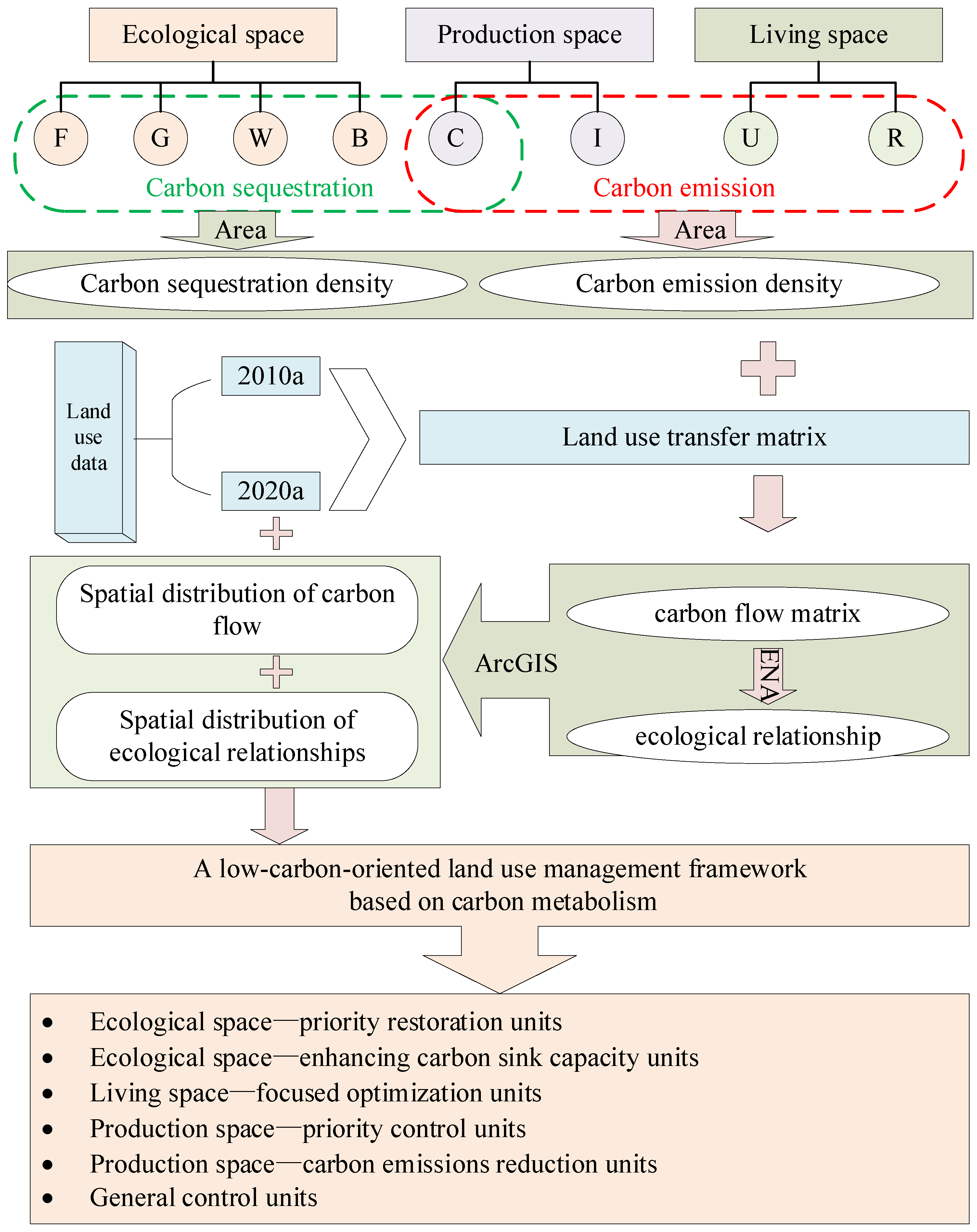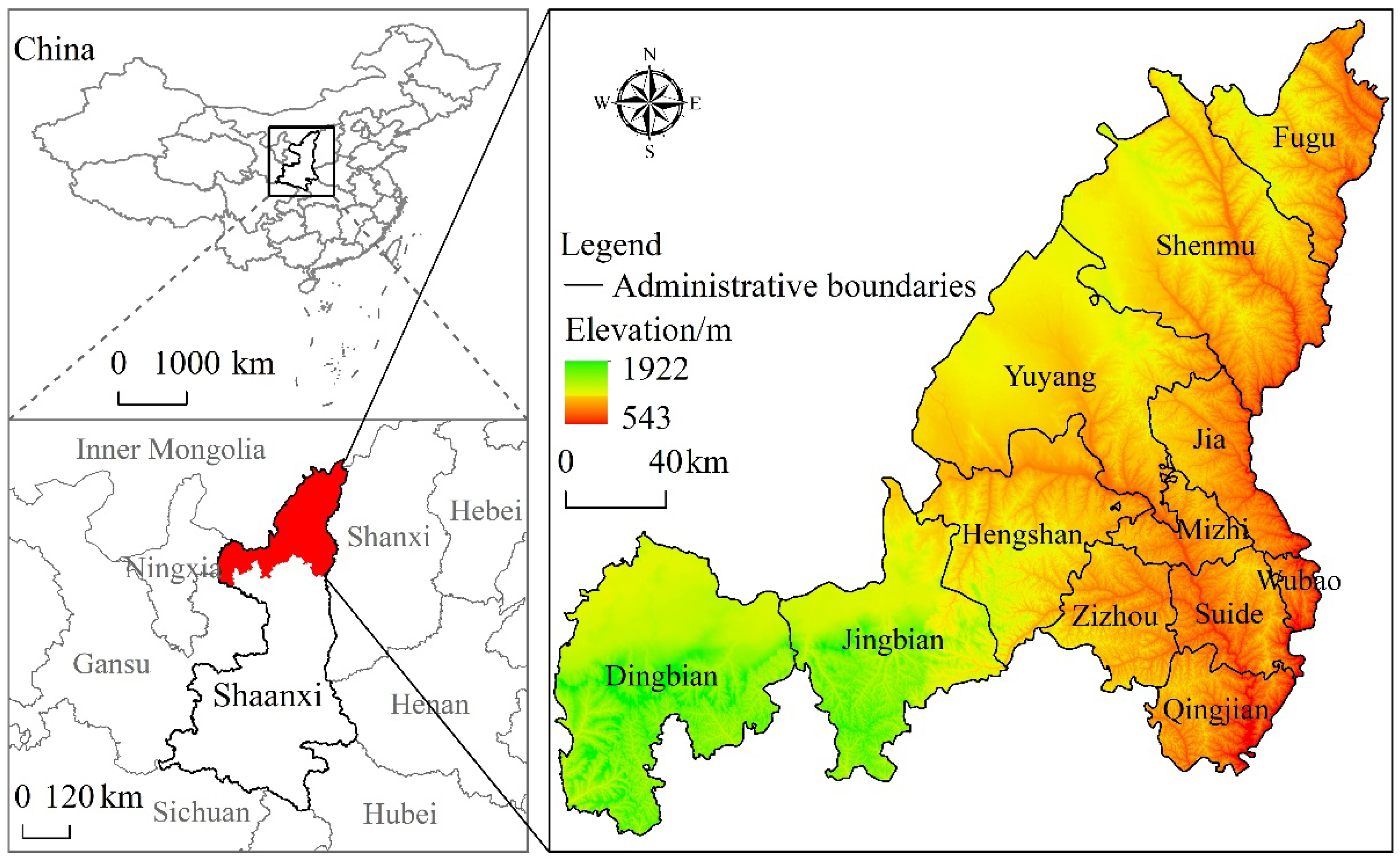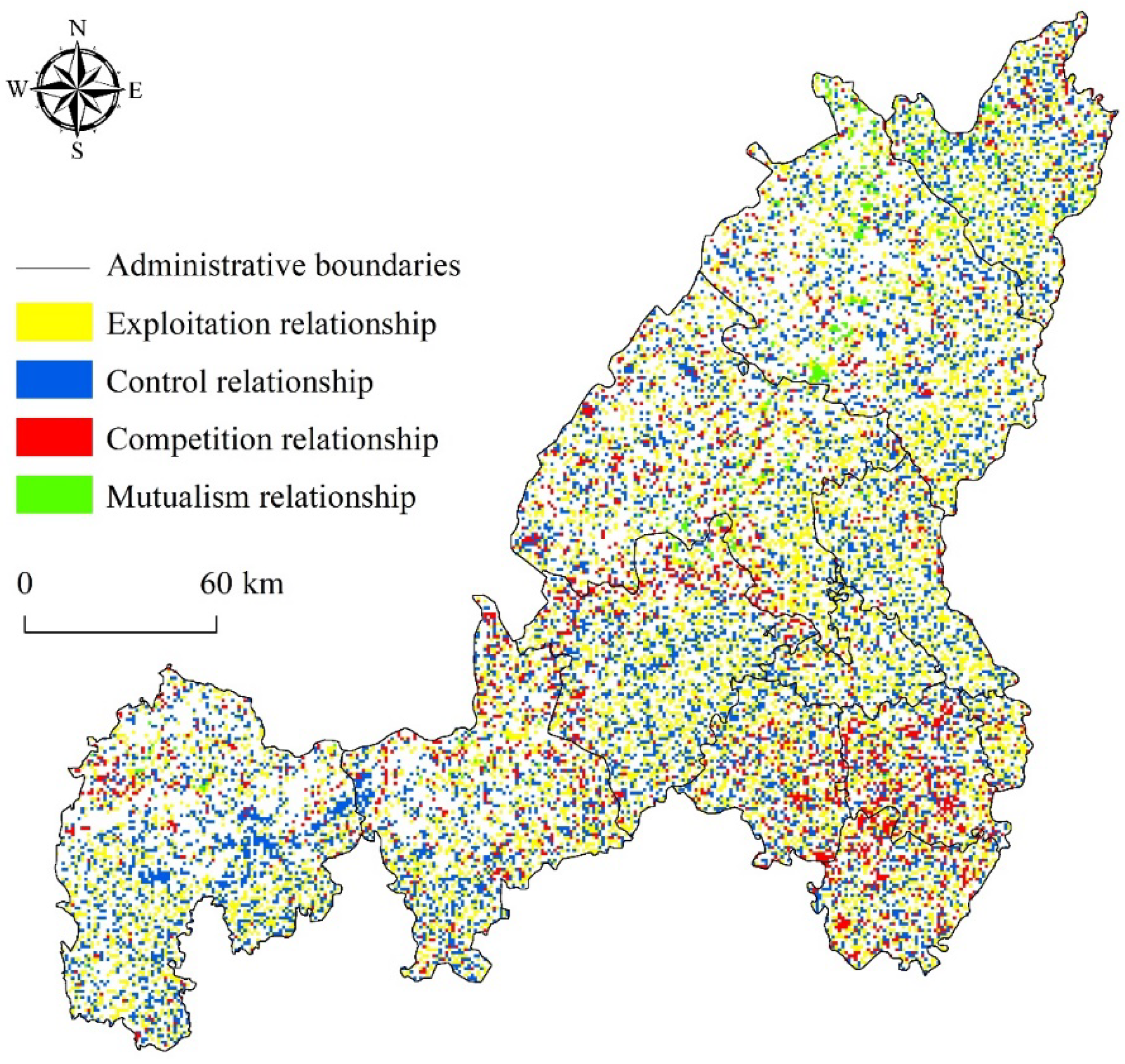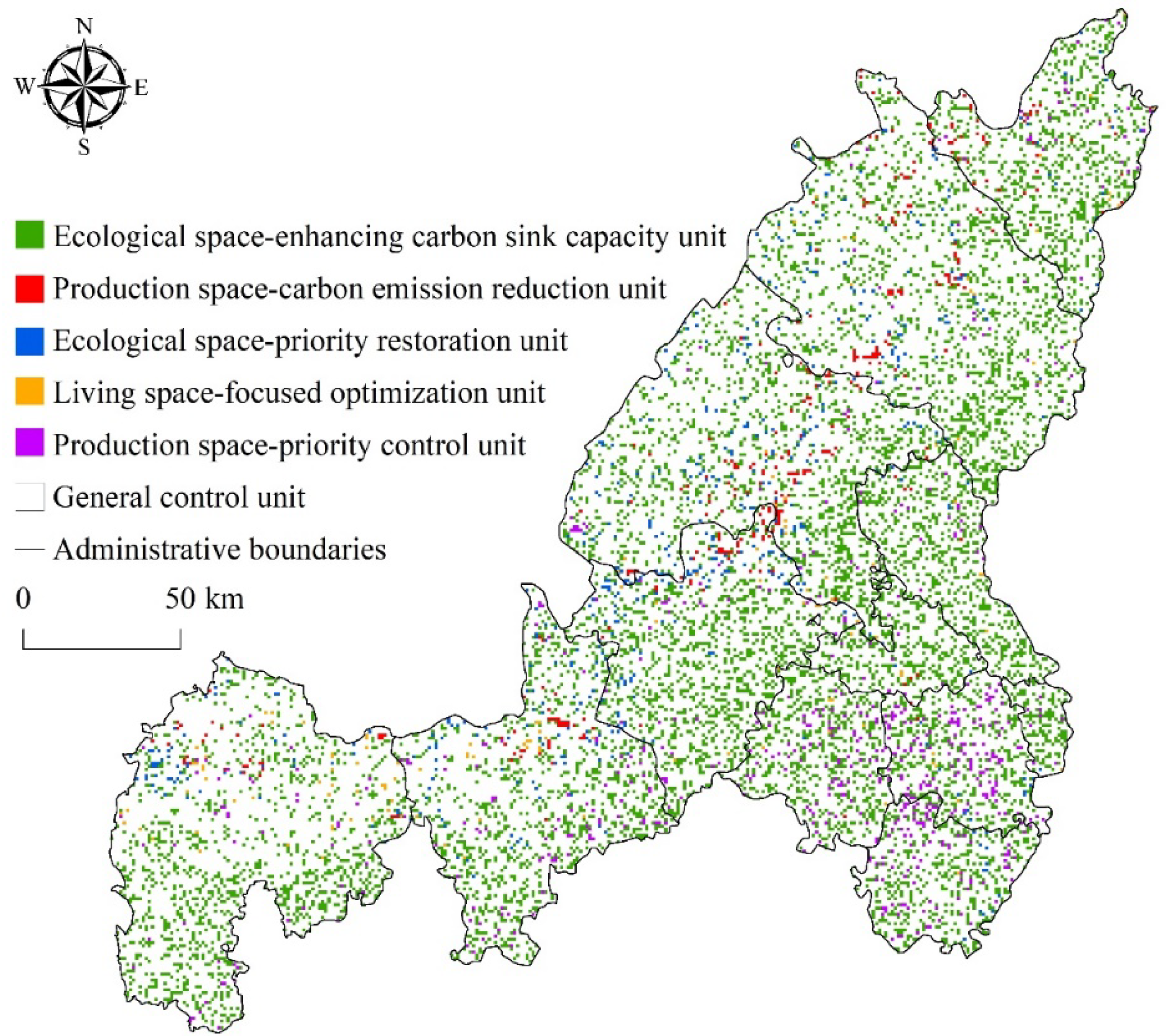A Low-Carbon Land Use Management Framework Based on Urban Carbon Metabolism: A Case of a Typical Coal Resource-Based City in China
Abstract
:1. Introduction
2. Materials and Methods
2.1. Study Area
2.2. Data Sources
2.3. Research Methods
2.3.1. Land Classification of “Ecological-Production-Living” Space
2.3.2. Carbon Metabolism in “Ecological-Production-Living” Space
- (1)
- Carbon emission from the biosphere to the atmosphere
- (2)
- Carbon sequestration from the atmosphere to the biosphere
- (3)
- Carbon flow caused by LUCC
2.3.3. Ecological Network Utility Analysis
3. Results
3.1. Carbon Metabolism in “Ecological-Production-Living” Space
3.2. Ecological Relationships among “Ecological-Production-Living” Space Land
3.3. Low-Carbon Land Use Management Framework in”Ecological-Production-Living” Space
- (1)
- Ecological space—priority restoration units
- (2)
- Ecological space—enhancing carbon sink capacity units
- (3)
- Living space—focused optimization units
- (4)
- Production space—priority control units
- (5)
- Production space—carbon emissions reduction units
- (6)
- General control units
4. Discussion
5. Conclusions
Supplementary Materials
Author Contributions
Funding
Institutional Review Board Statement
Informed Consent Statement
Data Availability Statement
Conflicts of Interest
References
- Zhang, W.; Duan, X. The research progress in the relationship among economic growth, industrial structure, and carbon emissions. Prog. Geogr. 2012, 31, 442–450. [Google Scholar]
- He, W.J.; Zhang, B. A comparative analysis of Chinese provincial carbon dioxide emissions allowances allocation schemes in 2030: An egalitarian perspective. Sci. Total Environ. 2021, 765, 142705. [Google Scholar] [CrossRef] [PubMed]
- Liu, X.P.; Wang, S.J.; Wu, P.J. Impacts of urban expansion on terrestrial carbon storage in China. Environ. Sci. Technol. 2019, 53, 6834–6844. [Google Scholar] [CrossRef] [PubMed]
- Abbasi, M.A.; Parveen, S.; Khan, S.; Kamal, M.A. Urbanization and energy consumption effects on carbon dioxide emissions: Evidence from Asian-8 countries using panel data analysis. Environ. Sci. Pollut. Res. 2020, 27, 18029–18043. [Google Scholar] [CrossRef] [PubMed]
- Hong, C.; Burney, J.A.; Pongratz, J.; Nabel, J.; Mueller, N.D.; Jackson, R.B.; Davis, S.J. Global and regional drivers of land-use emissions in 1961–2017. Nature 2021, 589, 554–561. [Google Scholar] [CrossRef] [PubMed]
- Friedlingstein, P.; Houghton, R.A.; Marland, G.; Hackler, J.; Boden, T.A.; Conway, T.J.; Canadell, J.G.; Raupach, M.R.; Ciais, P.; Le Quéré, C. Update on CO2 emissions. Nat. Geosci. 2010, 3, 811–812. [Google Scholar] [CrossRef]
- Pacheco-Torres, R.; Roldán, J.; Gago, E.J.; Ordóñez, J. Assessing the relationship between urban planning options and carbon emissions at the use stage of new urbanized areas: A case study in a warm climate location. Energy Build. 2017, 136, 73–85. [Google Scholar] [CrossRef]
- Zhang, R.; Matsushima, K.; Kobayashi, K. Can land use planning help mitigate transport-related carbon emissions? A case of Changzhou. Land Use Policy 2018, 74, 32–40. [Google Scholar] [CrossRef]
- Xu, W. The connotation, relationship and optimization path of “ecological-production-living” space. Dongyue Trib. 2022, 43, 126–134. [Google Scholar]
- Li, J.; Sun, W.; Yu, J. Change and regional differences of production-living-ecological space in the Yel-low River Basin: Based on comparative analysis of resource-based and non-resource-based cities. Resour. Sci. 2020, 42, 2285–2299. [Google Scholar]
- Dou, Y.; Ye, W.; Li, B.; Liu, P. Tourism adaptability of traditional village based on living-production-ecological spaces: A case study of Zhangguying Village. Econ. Geogr. 2022, 42, 215–224. [Google Scholar]
- Hu Jintao’s Report at the Eighteenth National Congress of the Communist Party of China. Available online: http://www.gov.cn/ldhd/2012-11/17/content_2268826.htm (accessed on 29 September 2022).
- Li, G.; Fang, C. Quantitative function identification and analysis of urban ecological-production-living spaces. Acta Geogr. Sin. 2016, 71, 49–65. [Google Scholar]
- Du, J.; Fu, J.; Hao, M. Analyzing the carbon metabolism of “Production-Living-Ecological” space based on ecological network utility in Zhaotong. J. Nat. Resour. 2021, 36, 1208–1223. [Google Scholar] [CrossRef]
- Eduardo, B.S.L.; Luís, F.M.N.; José, A.P.O. Carbon accounting approaches and reporting gaps in urban emissions: An analysis of the Greenhouse Gas inventories and climate action plans in Brazilian cities. J. Nat. Resour. 2020, 245, 118930. [Google Scholar] [CrossRef]
- Mark, S. Updated potential soil carbon sequestration rates on U.S. agricultural land based on the 2019 IPCC guidelines. Soil Tillage Res. 2020, 204, 104719. [Google Scholar] [CrossRef]
- Liang, X.; Fan, M.; Xiao, Y.; Yao, J. Temporal-spatial characteristics of energy-based carbon dioxide emissions and driving factors during 2004–2019, China. Energy 2022, 261, 124965. [Google Scholar] [CrossRef]
- Maurizio, C.; Maria, A.C.; Sonia, L. Energy-related GHG emissions balances: IPCC versus LCA. Sci. Total Environ. 2018, 628, 1328–1339. [Google Scholar]
- Ma, Y.; Shang, Y.; Fen, Y. Analysis on influence of spatial factors on carbon emissions of communities in Northern China: Taking Yantai as an example. Urban Dev. Stud. 2022, 29, 118–124. [Google Scholar]
- Kong, L.; Shi, Z.; Chu, L.M. Carbon emission and sequestration of urban turfgrass systems in Hong Kong. Sci. Total Environ. 2014, 473, 132–138. [Google Scholar] [CrossRef]
- Francisco, E.; Sebastian, V.; Wayne, Z. Analyzing the efficacy of subtropical urban forests in offsetting carbon emissions from cities. Environ. Sci. Policy 2010, 13, 362–372. [Google Scholar]
- Li, J.; Huang, G.; Liu, L. Ecological network analysis for urban metabolism and carbon emissions based on input-output tables: A case study of Guangdong province. Ecol. Model. 2018, 383, 118–126. [Google Scholar] [CrossRef]
- Breetz, H.L. Regulating carbon emissions from indirect land use change (ILUC): U.S. and California case studies. Environ. Sci. Policy 2017, 77, 25–31. [Google Scholar] [CrossRef]
- Xia, C. Multi-Scale Studies on Urban Carbon Metabolism from the Perspective of Land Use and Scenario Analysis of Emission Reduction. Ph.D. Thesis, Zhejiang University, Hangzhou, China, 2019. [Google Scholar]
- Xia, L.; Zhang, Y.; Yu, X.; Li, Y.; Zhang, X. Hierarchical structure analysis of urban carbon metabolism: A case study of Beijing, China. Ecol. Indic. 2019, 107, 105602. [Google Scholar] [CrossRef]
- Zhang, Y.; Xia, L.; Fath, B.D.; Yang, Z.; Yin, X.; Su, M.; Liu, G.; Li, Y. Development of a spatially explicit network model of urban metabolism and analysis of the distribution of ecological relationships: Case study of Beijing, China. J. Clean. Prod. 2016, 112, 4304–4317. [Google Scholar] [CrossRef]
- Zou, K.; Shu, Y.; Li, G.; Yan, Q.; Bao, Y.; Zhang, S.; Zhang, D. Urban Land-carbon Framework Construction Based on Ecological Network Analysis and Its Space-time Evolution Research. J. Ecol. Rural Environ. 2022, 38, 972–982. [Google Scholar]
- Lin, G.; Jiang, D.; Fu, J.; Cao, C.; Li, X.; Li, Z.; Huang, S. Carbon flow analysis for production-living-ecological space: A case study of Tangshan, China. Sci. Technol. Rev. 2020, 38, 107–114. [Google Scholar]
- Zhang, H.; Xu, E.; Zhu, H. An ecological-living-industrial land classification system and its spatial distribution in China. Resour. Sci. 2015, 37, 1332–1338. [Google Scholar]
- Kong, D.; Chen, H.; Wu, K. The evolution of “Production-Living-Ecological” space, eco-environmental effects and its influencing factors in China. J. Nat. Resour. 2021, 36, 1116–1135. [Google Scholar] [CrossRef]
- Hu, W.; Wang, L.; Shu, M. Reflections on delimiting the three basic spaces in the compilation of urban and rural plans. City Plan. Rev. 2016, 40, 21–26. [Google Scholar]
- Jiang, D.; Lin, G.; Fu, J. Discussion on scientific foundation and approach for the overall optimization of “Production-Living-Ecological” space. J. Nat. Resour. 2021, 36, 1085–1101. [Google Scholar] [CrossRef]
- Tian, Y.; Zhang, J. Regional differentiation research on net carbon effect of agricultural production in China. J. Nat. Resour. 2013, 28, 1298–1309. [Google Scholar]
- Wang, S.; Tian, S.; Cai, Q.; Wu, Q. Driving factors and carbon transfer of industrial carbon emissions in Guangdong province under the background of industrial transfer. Geogr. Res. 2021, 40, 2606–2622. [Google Scholar]
- Fang, J.; Guo, Z.; Pu, S.; Chen, A. Estimation of carbon sinks in China′s terrestrial vegetation from 1981 to 2000. Sci. China Ser. D 2007, 37, 804–812. [Google Scholar]
- Lai, L. Research on Carbon Emission Effects of Land Use in China. Ph.D. Thesis, Nanjing University, Nanjing, China, 2010. [Google Scholar]
- Duan, X.; Wang, X.; Lu, F.; Ouyang, Z. Carbon sequestration and its potential by wetland ecosystems in China. Acta Ecol. Sin. 2008, 28, 463–469. [Google Scholar]
- Wei, J.; Xia, L.; Chen, L.; Zhang, Y.; Yang, Z. A network-based framework for characterizing urban carbon metabolism associated with land use changes: A case of Beijing city, China. J. Nat. Resour. 2022, 371, 133695. [Google Scholar] [CrossRef]
- Xia, C.; Li, Y.; Ye, Y.; Shi, Z.; Liu, J.; Li, X. Analyzing urban carbon metabolism based on ecological network utility: A case study of Hangzhou City. Acta Ecol. Sin. 2018, 38, 73–85. [Google Scholar]







| “Ecological-Production-Living” Space | Land Use Type and Code |
|---|---|
| Ecological space | Woodland (F) Grassland (G) Water (W) Unused land (B) |
| Production space | Cultivated land (C) Industrial, mining and transportation land (I) |
| Living space | Urban land (U) 1 Rural residential land (R) 2 |
| Land Use Type | 2010 | 2020 | ||
|---|---|---|---|---|
| Carbon Emissions | Carbon Sinks | Carbon Emissions | Carbon Sinks | |
| C | 26.54 | 119.23 | 35.04 | 192.26 |
| F | 1349.03 | 1411.92 | ||
| G | 3.93 | 4.00 | ||
| W | 1.37 | 1.18 | ||
| U | 12.55 | 16.11 | ||
| R | 15.16 | 12.92 | ||
| I | 8524.81 | 38,219.30 | ||
| B | 0.02 | 0.02 | ||
| Sum | 8579.07 | 1473.59 | 38,283.36 | 1609.38 |
Publisher’s Note: MDPI stays neutral with regard to jurisdictional claims in published maps and institutional affiliations. |
© 2022 by the authors. Licensee MDPI, Basel, Switzerland. This article is an open access article distributed under the terms and conditions of the Creative Commons Attribution (CC BY) license (https://creativecommons.org/licenses/by/4.0/).
Share and Cite
Li, L.; Bai, Y.; Yang, X.; Gao, Z.; Qiao, F.; Liang, J.; Zhang, C. A Low-Carbon Land Use Management Framework Based on Urban Carbon Metabolism: A Case of a Typical Coal Resource-Based City in China. Sustainability 2022, 14, 13854. https://doi.org/10.3390/su142113854
Li L, Bai Y, Yang X, Gao Z, Qiao F, Liang J, Zhang C. A Low-Carbon Land Use Management Framework Based on Urban Carbon Metabolism: A Case of a Typical Coal Resource-Based City in China. Sustainability. 2022; 14(21):13854. https://doi.org/10.3390/su142113854
Chicago/Turabian StyleLi, Lingwei, Yongping Bai, Xuedi Yang, Zuqiao Gao, Fuwei Qiao, Jianshe Liang, and Chunyue Zhang. 2022. "A Low-Carbon Land Use Management Framework Based on Urban Carbon Metabolism: A Case of a Typical Coal Resource-Based City in China" Sustainability 14, no. 21: 13854. https://doi.org/10.3390/su142113854
APA StyleLi, L., Bai, Y., Yang, X., Gao, Z., Qiao, F., Liang, J., & Zhang, C. (2022). A Low-Carbon Land Use Management Framework Based on Urban Carbon Metabolism: A Case of a Typical Coal Resource-Based City in China. Sustainability, 14(21), 13854. https://doi.org/10.3390/su142113854










